

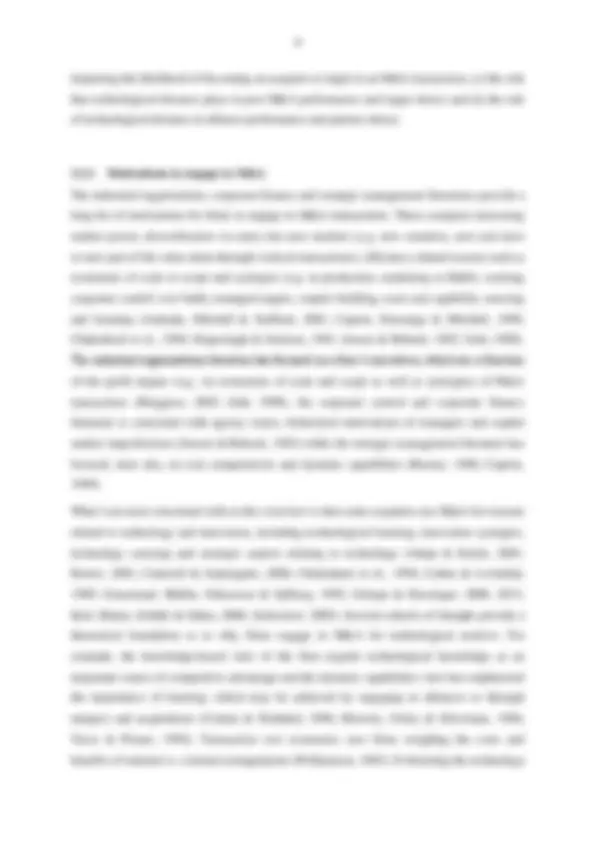






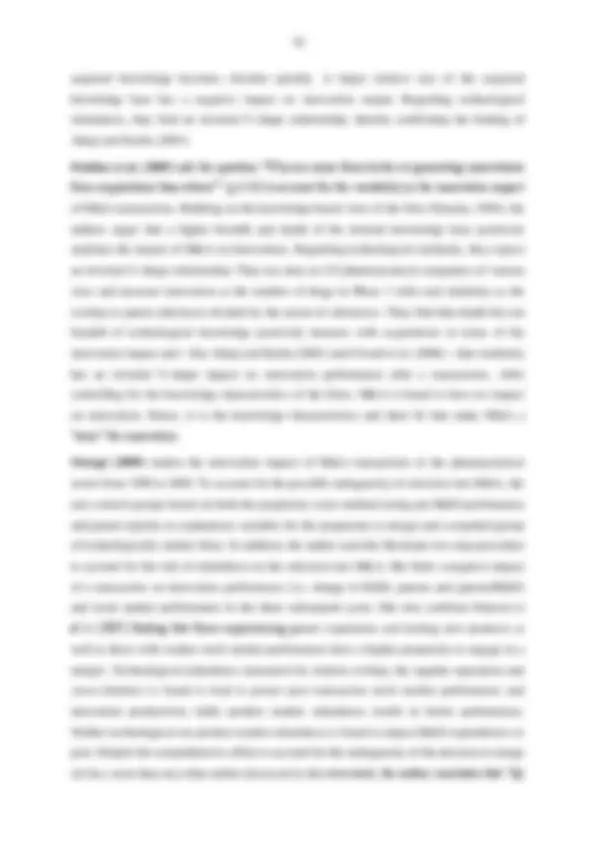














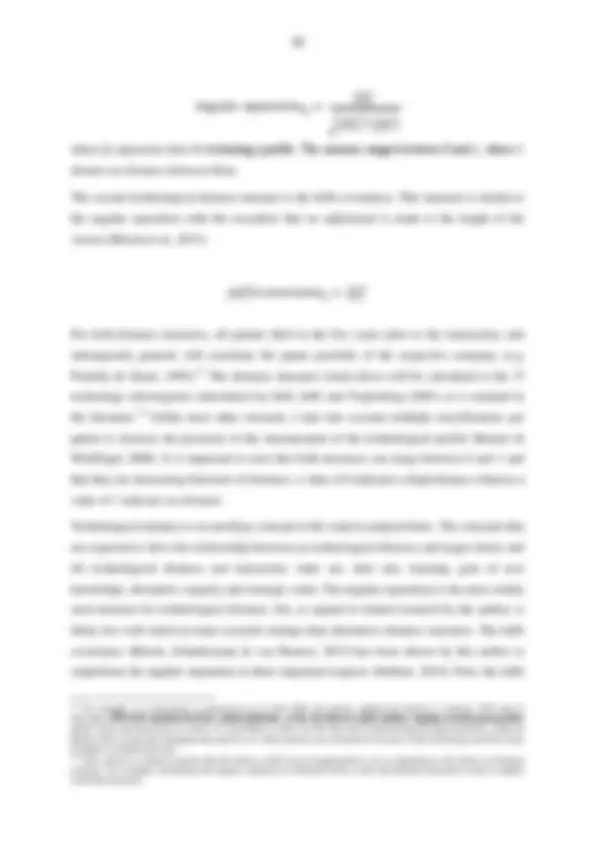


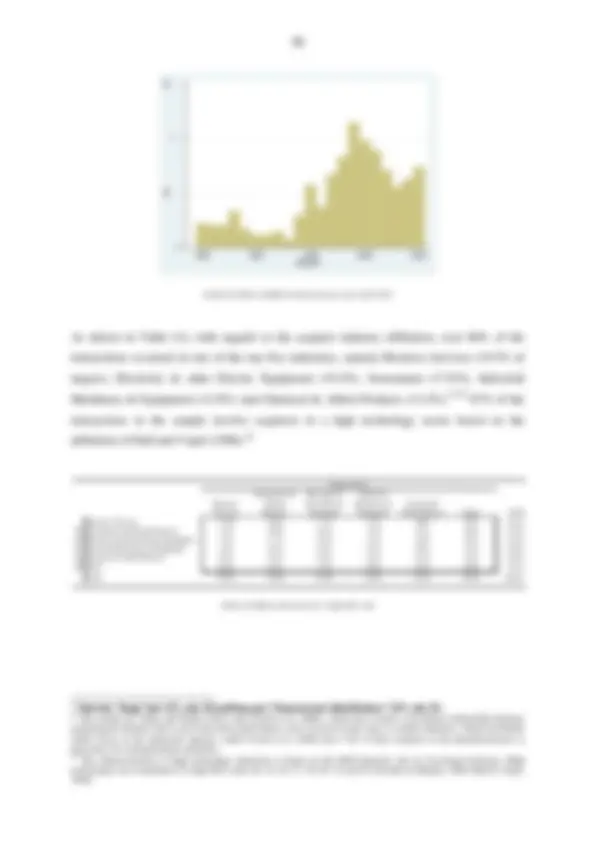
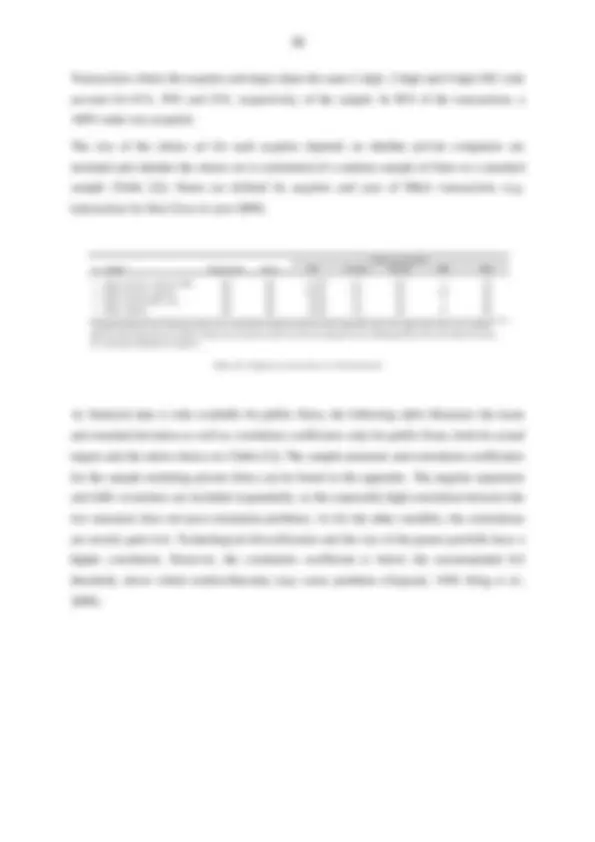
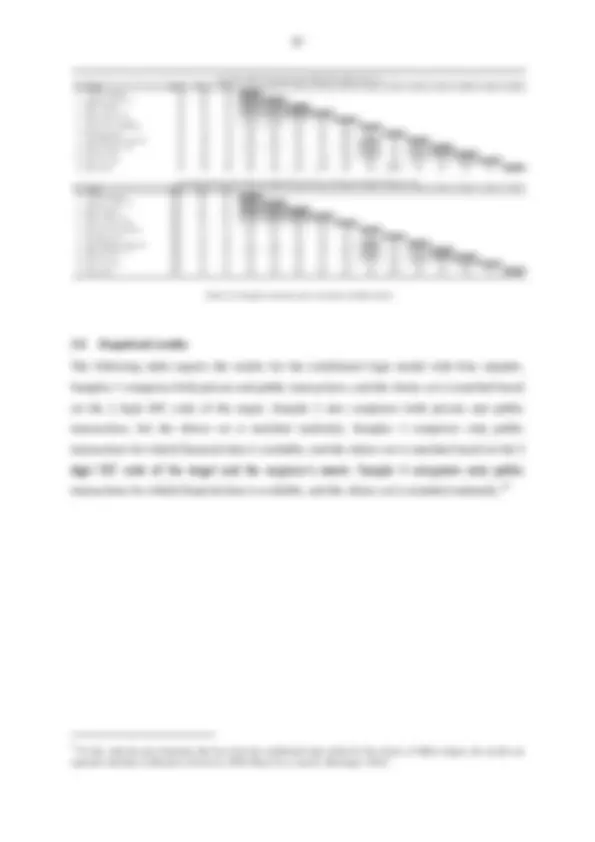
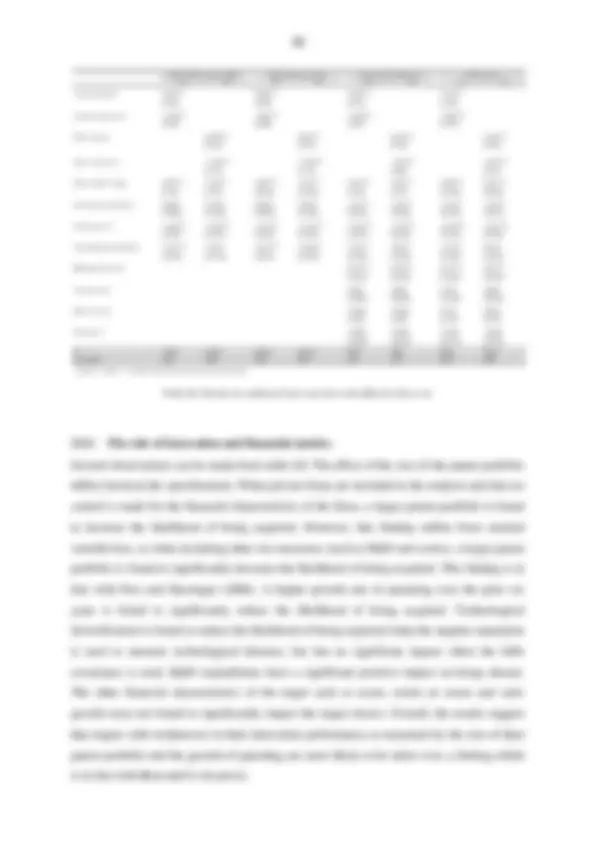


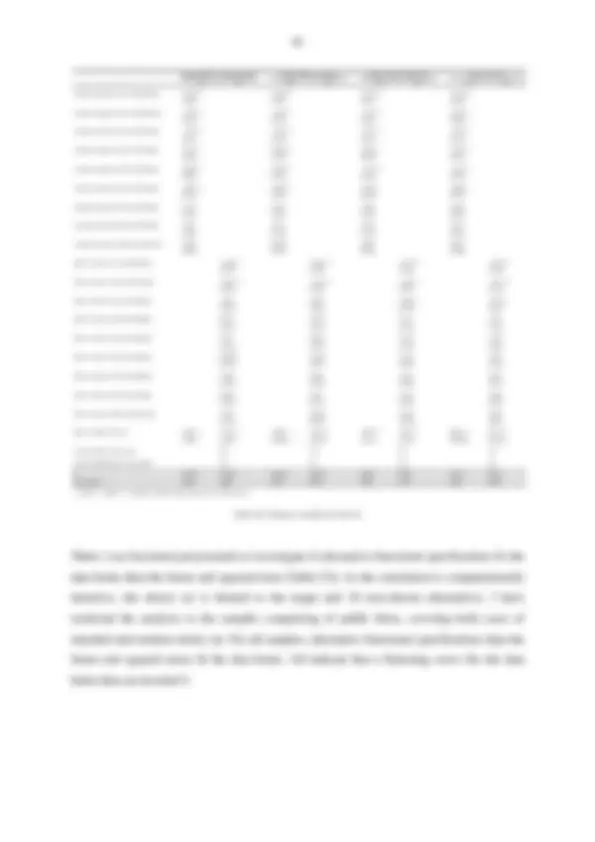

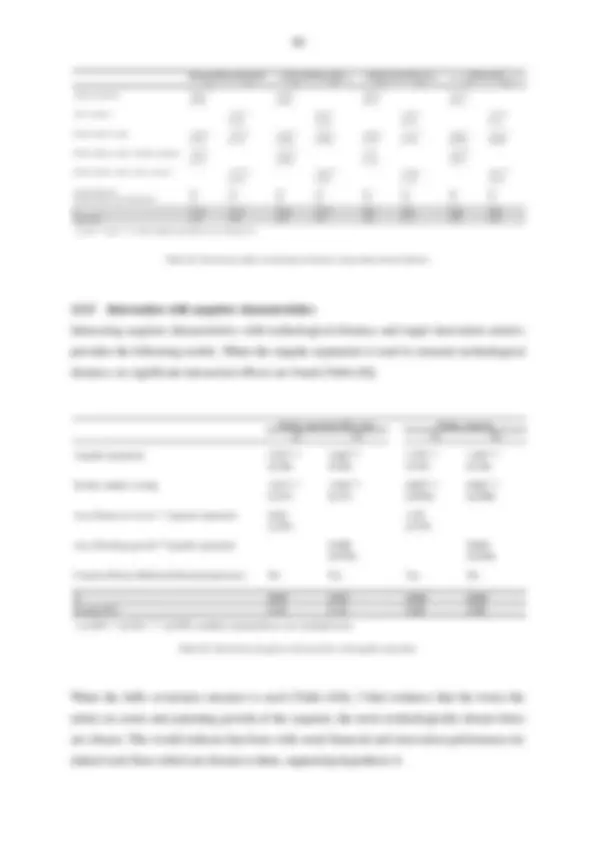

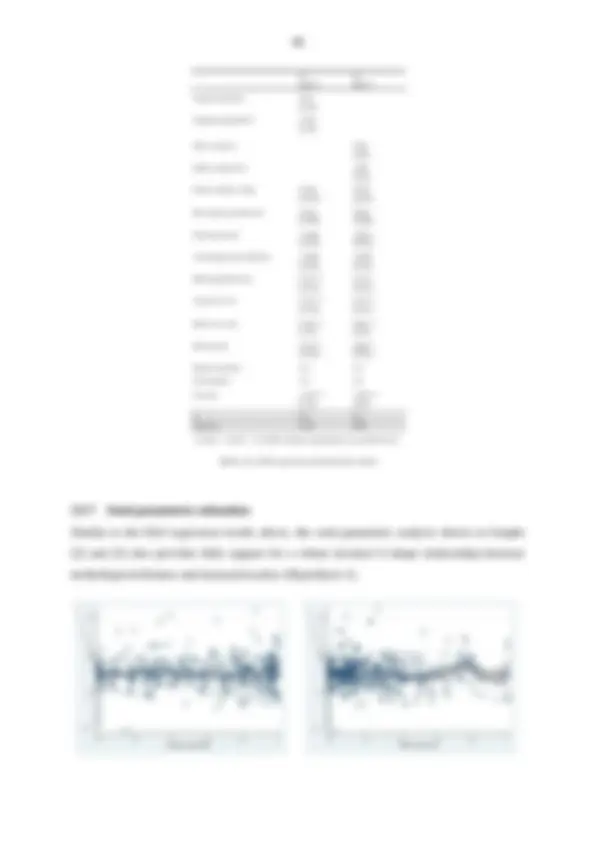










Study with the several resources on Docsity

Earn points by helping other students or get them with a premium plan


Prepare for your exams
Study with the several resources on Docsity

Earn points to download
Earn points by helping other students or get them with a premium plan
Community
Ask the community for help and clear up your study doubts
Discover the best universities in your country according to Docsity users
Free resources
Download our free guides on studying techniques, anxiety management strategies, and thesis advice from Docsity tutors
On the one hand, abundant research has found that the innovation performance after the acquisition is best when the target and acquirer have an intermediate ...
Typology: Slides
1 / 53

This page cannot be seen from the preview
Don't miss anything!














































Florian Stellner, Max Planck Institute for Innovation and Competition
[DRAFT, October 2014]
ABASTRACT: Using a sample of 538 M&A transactions covering public and private US firms in a wide range of predominantly high technology industries, I investigate how the innovation characteristics of the target as well as the technological and product market distance between the target and the acquirer affect the acquirer’s choice of M&A targets and the transaction price. I match a set of non-chosen alternatives, either based on target sector affiliation and size or randomly, to each acquirer and estimate a conditional logit model. I show that the existence of an inverted U-shape relationship between technological distance and the likelihood of being chosen as a target is not very robust. Overall acquirers appear to prefer technologically close firms as targets. The higher the product market (technological) distance between the acquirer and the target, the more do acquirers prefer firms which are close in technological (product market) space. Regarding the role of acquirer characteristics, I find that the lower the acquirer’s return on assets and patenting growth, the more technologically distant firms are chosen. The relationship between technological distance and the transaction price is also investigated parametrically and semi-parametrically, but no statistically robust inverted U-shape relationship is found. I also provide possible explanations for the apparent inconsistency between the evidence found herein and previous studies on the impact of technological distance on post M&A innovation performance. These comprise insufficient robustness checks of the post M&A evidence and management myopia.
3.1 Introduction Mergers and acquisitions (M&A) occur for a variety of reasons and these reasons differ significantly between industries and over time. One motivation to engage in M&A transactions, particularly in the most recent M&A wave and in industries such as ICT and pharmaceuticals, is related to technology and innovation (Chakrabarti, Hauschildt & Süverkrüp, 1994; Sleuwaegen & Valentini, 2006). M&A transactions allow companies to
source existing technologies, thereby filling gaps in their technology portfolio quicker than is feasible via in-house development and possibly in areas that are too distant for profitable in- house development (Capron & Mitchell, 2009; Schweizer, 2005). Also, it provides a mechanism to learn about the other firm’s technologies, to recombine knowledge and technologies residing in different firms and thereby to generate innovations (Kogut & Zander, 1992; Valentini & DiGuardo, 2012). In contrast to other channels for external technology sourcing, such as alliances, licensing or the purchase of patents, M&A provides a high degree of control, thereby alleviating agency and moral hazard problems, combined with the potential to effectively transfer tacit knowledge and complementary resources (Keil, Maula, Schildt & Zahra, 2008; Khanna, Gulati & Nohria, 1998; Ranft & Lord, 2002).
This study focuses predominantly on the role that technological distance plays in the selection of M&A targets and the transaction price.^1 It is built on the assumption that acquirers can successfully outbid other firms that expect fewer synergies from an M&A transaction, which is reflected in successful bids and the level of the transaction value (Barney, 1988; Grimpe & Hussinger, 2013; Hall, 1988a). Hence, I seek to investigate, inter alia, whether the expected synergies are highest when the acquirer and target exhibit a low, intermediate or high level of technological distance.
From a theoretical perspective, technological distance can be beneficial as well as detrimental. Proximity is likely to be associated with higher contemporary absorptive capacity, i.e. a higher ability to assimilate and apply the acquired knowledge as well as fewer information asymmetries regarding the assessment and valuation of the technological opportunity that a potential target offers (Cohen & Levinthal, 1990). Economies of scale are also more likely if two companies share the same methods of search, tools and procedures. With patents having strategic value in addition to embodying technological knowledge, acquiring a firm which has patents in technologically close fields may allow the acquirer to conduct its R&D activities in a less constrained manner and possibly to restrain competitors in their innovation efforts by erecting a patent fence (Grimpe & Hussinger, 2008, 2013). However, too much proximity is likely to constrain learning opportunities, gain of new knowledge and the acquisition of future absorptive capacity to assimilate and evaluate subsequent opportunities in the target’s technology fields (Ahuja & Katila, 2001; Nooteboom, Van Haverbeke, Duysters, Gilsing & Van den Oord, 2007; Sapienza, Parhankangas & Autio, 2004).
(^1) Authors have used the terms technological relatedness, technological proximity or technological overlap to refer to the same concept (e.g. Ahuja & Katila, 2001; Grimpe & Hussinger, 2013). Other authors have used the terms complementarity, fit or similarity (e.g. Marki, Hitt & Lane, 2010). As noted by Dehne (2013), there is a high degree of ambiguity in the use of the terms by different authors.
impacting the likelihood of becoming an acquirer or target in an M&A transaction, (c) the role that technological distance plays in post M&A performance and target choice and (d) the role of technological distance in alliance performance and partner choice.
3.2.1 Motivations to engage in M&A The industrial organizations, corporate finance and strategic management literatures provide a long list of motivations for firms to engage in M&A transactions. These comprise increasing market power, diversification via entry into new markets (e.g. new countries, new end users or new part of the value chain through vertical transactions), efficiency related reasons such as economies of scale or scope and synergies (e.g. in production, marketing or R&D), exerting corporate control over badly managed targets, empire building, asset and capability sourcing and learning (Andrade, Mitchell & Stafford, 2001; Capron, Dussauge & Mitchell, 1998; Chakrabarti et al., 1994; Haspeslagh & Jemison, 1991; Jensen & Ruback, 1983; Seth, 1990). The industrial organizations literature has focused on a firm’s incentives, which are a function of the profit impact (e.g. via economies of scale and scope as well as synergies) of M&A transactions (Berggren, 2003; Seth, 1990), the corporate control and corporate finance literature is concerned with agency issues, behavioral motivations of managers and capital market imperfections (Jensen & Ruback, 1983) while the strategic management literature has focused, inter alia, on core competencies and dynamic capabilities (Barney, 1988; Capron, 1999).
What I am most concerned with in this overview is that some acquirers use M&A for reasons related to technology and innovation, including technological learning, innovation synergies, technology sourcing and strategic aspects relating to technology (Ahuja & Katila, 2001; Bower, 2001; Cantwell & Santangelo, 2006; Chakrabarti et al., 1994; Cohen & Levinthal, 1989; Granstrand, Bohlin, Oskarsson & Sjöberg, 1992; Grimpe & Hussinger, 2008, 2013; Keil, Maula, Schildt & Zahra, 2008; Schweizer, 2005). Several schools of thought provide a theoretical foundation as to why firms engage in M&A for technological motives. For example, the knowledge-based view of the firm regards technological knowledge as an important source of competitive advantage and the dynamic capabilities view has emphasized the importance of learning, which may be achieved by engaging in alliances or through mergers and acquisitions (Conner & Prahalad, 1996; Mowery, Oxley & Silverman, 1996; Teece & Pisano, 1994). Transaction cost economics sees firms weighing the costs and benefits of internal vs. external arrangements (Williamson, 1985). If obtaining the technology
by acquiring another company is cheaper than developing the technology in-house, then a company would prefer to engage in M&A rather than spending more on R&D. For example, the incentives to innovate differ between small and large companies, affecting both the productivity and direction of innovation, and it may therefore be optimal for a large established company to buy small innovative start-up companies to source new technologies (Grandstand & Sjölander, 1990). The acquisitions of innovative pharmaceutical and biotech companies by large pharmaceutical companies to cope with rising R&D costs via economies of scale and scope and to develop a new generation of drugs or to fill the product pipeline with new drugs developed by another firm to address the “patent cliff” are examples for technologically motivated transactions (Danzon et al., 2007; Higgins & Rodriguez, 2006; Munos, 2009). Schweizer (2005) finds that pharmaceutical companies acquire biotech companies both to obtain existing products as well as to obtain the capabilities to develop new drugs to grow in the future. In the telecommunications sector, Cisco is frequently cited as a firm that has extensively used acquisitions to obtain existing technologies as well as key personnel such as programmers and engineers (Mayer & Kenney, 2004; Ranft & Lord, 2000). Until 2001, Cisco has acquired 71 companies for over 34.5 billion USD (Mayer & Kenney, 2004). From 2002 to 2013 it has added another 96 acquisitions to this count.^3 Mayer and Kenney (2004) note: “More than any other high-technology firm in history, Cisco has built its dominant market position through acquisition” (p. 299). The authors describe, inter alia, how Cisco reacted to the technological change from routers to switches in the early 1990s by acquiring a company engaged in switches, a technology Cisco was too late in developing internally. Technological motivations for acquiring another company can come in various forms. The following is a non-exhaustive and non-exclusive list of such motivations:
Cost driven motivations such as economies of scale (spreading fixed costs over more of the same R&D output) or scope (spreading fixed costs over different R&D activities) in R&D activities (Cassiman & Ueda, 2006). Also, an M&A transaction can be used to avoid the duplication of R&D projects (Comanor & Scherer, 2013).
Creating synergies by combining capabilities to create new opportunities. For example a company may acquire a company with complementary technological knowledge with the aim of using the recombined technological competencies to become more
(^3) http://www.cisco.com/web/about/doing_business/corporate_development/acquisitions/ac_year/about_cisco_acquisition _years_list.html (last accessed: 23 May 2014)
scale and scope and may allow scientists to specialize and become more productive (Henderson & Cockburn, 1996).^5
The motivations play a crucial role in assessing the two-way relationship between technological relatedness and M&A transactions. For example, if the main objective is to diversify technologically, then a company is likely to search for companies with a higher technological distance; if the objective is to generate economies of scale and to avoid duplication, the acquired company should be rather close in technology space.
When it comes to obtaining new technological capabilities, firms can choose between internal development (e.g. building a new R&D laboratory) and external sourcing (e.g. via alliances or M&A) (Capron & Mitchell, 2009). Potential advantages of external sourcing are that it allows companies to overcome larger capability gaps, to enter a new technology field more quickly and to provide a means for renewal that potentially faces less social rejection (Capron & Mitchell, 2009; Penrose, 1959). Technological distance plays a key role in weighing the costs and benefits of external technology and knowledge sourcing against internal development. With internal generation of knowledge and technology being path dependent, acquisitions of external technology and knowledge may be preferable if a company wants go get access to distant technologies quickly (Capron & Mitchell, 2009; Graebner, Eisenhardt & Roundy, 2010; Kogut & Zander, 1992). Against this, external sourcing is often associated with integration costs, cultural misfit, inability to cherry-pick and ex ante uncertainty as to what exactly is sourced externally.
3.2.2 The impact of innovation characteristics on becoming an M&A acquirer or target Regarding the causality running from innovation to M&A, researchers have investigated the innovation characteristics of firms that make them more likely to be acquirers or targets and the relationship between the firms (e.g. in the form of similarity in terms of size, innovativeness, technological focus, geographic location, etc.) that makes two firms more likely to merge. Different predictions are given by the literatures. The corporate control literature regards M&A as a means of reallocating resources of inefficiently run companies to a more capable management team (Jensen & Ruback, 1983; Manne, 1965). Hence, it predicts that it is underperformers that are targets of M&A transactions. The resource based view and knowledge based view (Kogut & Zander, 1992; Nelson & Winter, 1982) literatures regard
(^5) However, there are also theoretical arguments and empirical evidence, that small firms provide better incentive to innovate (Grandstand & Sjölander, 1990)
M&A as a way to source new competencies and knowledge. Hence, it predicts that target firms must possess valuable resources (e.g. patents, technological capabilities, key technological personnel) in order to attract the interest of possible acquirers. The following is an overview of the empirical literature that investigates the characteristics of acquirer and targets.^6
Using data on the M&A activity of 217 firms in the US electronics and electrical equipment industry from 1985 to 1993, Bloningen and Taylor (2000) find that R&D intensive firms are significantly less likely to engage in M&A activity as an acquirer. Under the assumptions that it is technology that is sourced though the acquisitions, they interpret this finding as support for the conjecture that some firms are using the M&A market to buy technologies while others make the technologies in-house, i.e. M&A and in-house R&D are substitutive.
Desyllas and Hughes (2009) analyze the innovation characteristics of acquired firms in high technology industries to test whether acquirers search for “superiority” as suggested by the resource based view (Penrose, 1959) or “inferiority” as suggested by the market for corporate control theory (Manne, 1965). They find that target firms exhibit a high R&D intensity (R&D/assets) and large patent stock compared to non-acquired firms, but at the same time a lower R&D productivity (successful patent applications/assets) and a weak financial performance. They argue that targets are firms that have been strong innovators in the past but are falling behind in terms of innovation and financial performance recently.
Using data on the M&A activity of 2,500 manufacturing firms over the period 1976-1985, Hall (1988a) investigates the selection into M&A based on a matching process in which a firm maximizes the gains from a transaction, taking into account target characteristics and the relatedness between the target and acquirer. She finds that firms are more likely to merge if they are similar in size and R&D intensity. As the R&D conducted by the target was valued relatively higher by the acquiring firm, she argues that targets are successful innovators. Higher value gains were found if both firms have a high R&D intensity. In a subsequent paper, Hall (1990) analyzes 2,500 transactions involving US manufacturing firms from 1967 to 1987 and finds that a lower R&D intensity increases the chances of being a target for private and foreign firms and has no impact on being an acquirer.
Using case study and survey data on Swedish firms, Grandstand and Sjölander (1990) find that large Swedish firms tend to acquire small innovative firms. Their work builds on Williamson (1975) who argued that neither large nor small firms have an advantage in all (^6) The impact of M&A on ex post innovation performance is not discussed in this overview. I refer the reader my related research that discusses this aspect (Stellner, 2014c)
Using CIS data from 1993 on 269 Belgian firms, Cassiman and Veugelers (2006) investigate whether M&A and internal R&D are complementary, i.e. whether one activity increases the marginal return of the other activity. Their results reveal the presence of complementarity between M&A and R&D and that this complementarity is positively mediated by the focus on basic R&D. This basic R&D is presumed to provide the absorptive capacity to make use of the external knowledge obtained through M&A.
3.2.3 The role of technological relatedness As for the selection of M&A targets as well as the ex post innovation performance, technological relatedness can have a positive as well as negative impact. One core argument is based on absorptive capacity: the higher the similarity of two firms’ knowledge bases, the lower are information asymmetries and the easier it is to identify, evaluate and assimilate the acquired knowledge (Cohen & Levinthal, 1990; Haspeslagh & Jemison, 1991; Kogut & Zander, 1992; Lane & Lubatkin, 1998). Zahra and George (2002) distinguish between potential absorptive capacity, which refers to the ability to identify and understand the opportunity before acting, and realized absorptive capacity, which is concerned with the assimilation, transformation and exploitation. Potential absorptive capacity can lower the asymmetric information regarding the outlook and value of an opportunity. While asymmetric information exists as well with regards to product market opportunities, customer relationships and financial data, the high uncertainty of new technological developments and the difficult assessment of tacit knowledge are likely to make asymmetric information particularly pronounced in the technology field (Hussinger, 2010). The absorptive capacity can be positively affected by a high technological proximity between the acquirer and target as well as prior technological relations, e.g. in the form of technology flows or prior technology alliances (Al-Laham, Schweizer & Amburgey, 2010). In addition to aspects pertaining to the companies’ knowledge bases, there is a strategic component that has to be taken into account (Grimpe and Hussinger, 2008, 2013). Patents constitute a right to exclude other firms from using the patent owner’s technology (also known as the “preemptive power”). By acquiring a company that has patents in technologically close fields, a firm may be able to conduct its R&D activities more freely ex post or to erect a patent fence that restricts competitors in their innovation efforts.
However, too much similarity, like too much distance, constrains the acquirer’s opportunities for learning (Sapienza, Parhankangas & Autio, 2004). Acquiring distant technologies allows companies to solve problems in a new way, either standalone or in combination with the
acquirer’s technologies (Ahuja & Katila, 2001; Cohen & Levinthal, 1990). Also, acquiring distant technologies provides the future absorptive capacity to understand, value and assimilate these technologies going forward (Ahuja & Katila, 2001). This capacity may then be used to make further acquisitions or establish alliances in these technological fields. Finally, acquiring distant technologies constitutes a way to reduce risk via technological diversification.
There are two streams in the literature that I will discuss. First, there is research which investigates the choice of acquisition target, investigating if acquirers search for targets that are close or distant to them in technology space. Second, there is a stream of research which looks at the performance, either in terms of innovation or financials, of the combined entity depending on the ex ante technological distance between the two firms. I begin with the empirical studies that investigate the selection into M&A.
Using data on 242 acquisitions among top patenting firms (predominantly involving US targets), AlAzzawi (2008) uses Hall’s (1988a) matching model to test the role of actual pre- acquisition knowledge flows (measured by bilateral patent citations) as well as potential knowledge flows (measured by technological distance) on the merger choice decision. The gain of a transaction is a linear function of the technological properties of the target and the distance and knowledge flows between them. She finds that prior knowledge flows as well as technological proximity have a significant positive impact on the merger pairing. Unfortunately, she does not test for a non-linear impact. The size of the patent portfolio of the target has a significant negative impact on being acquired, while the number of global citations and the difference in the number of global citations between target and acquirer have no impact. Finally, firms tend to acquire during times of low patenting output and firms tend to be acquired during times of widely cited patenting output.
Based on a sample of German firms, including many SME, and using Hall’s (1988a) matching model, Hussinger (2010) , finds that firms which are technologically close are preferred as targets. No indication of a non-linear effect of technological distance on the choice of M&A target is found. She finds that technological proximity is statistically relevant for SME but not for larger firms, the latter possibly being a result of the small sample size. She included geographical and product market proximity as additional explanatory variables, finding that both have a positive impact on the likelihood of being chosen as a target.
Frey and Hussinger (2006) analyze cross-border as well domestic M&A transactions in Europe from 1994 to 2000 and the role that technology plays in these transactions. They also
the treatment group than in the control group (measured as the patenting of the target and acquirer whose transaction failed) if the companies are technologically close prior to the transaction. The authors argue that the technological overlap is a source of synergies and that this drives the decision which firms to acquire and the post-transaction performance.
In a study covering 1,428 M&A transactions from 1997 to 2010 involving European firms, Grimpe and Hussinger (2013) account for the fact that patents not only characterize the knowledge base of companies but also have a preemptive power owing to the legal title that allows the owner to exclude third parties from using the technology. In contrast to the above studies which use the choice of acquiring a firm as the dependent variable, they use the acquisition price as the dependent variable. The study is nevertheless closely related to the target choice studies as both are concerned with the expected synergies from a transaction. Using the information on X or Y citations (indicating conflicting prior art) and A citations (indicating no conflicting prior art) received by the targets patents, the preemptive power of the target is measured by the share of XY-type citations received by the target’s patents in the target’s citation stock. They find that the preemptive power of the target results in higher acquisition prices paid by the acquirer. This relationship is positively mediated by the acquirer’s technology intensity as this increases the potential damage that external patents can cause to the firm as well as the potential benefit of owning patents and thereby establishing a patent fence. Regarding the technological relatedness – measured by the angular separation established at the IPC class level – they find an inverted U-shape relationship, i.e. an intermediate level of technological relatedness is found to result in the highest acquisition prices. This is contrary to the above findings that firms choose technologically close targets but fits well with the findings below that an intermediate level of technological relatedness is most conducive to ex post innovation performance. The authors also include two distinct relatedness measures, one between the acquirer’s A-cited patents and the target’s A-cited patents (thereby measuring the “knowledge base” component of relatedness) as well as the one between the acquirer’s A-cited patents and the target’s XY-cited patents (thereby measuring the “preemptive” component of relatedness). While the A-cited/A-cited relatedness measure has again an inverted U-shape relationship with acquisition price, the A-cited/XY- cited relatedness measure has a positive relationship with the acquisition price (and an insignificant squared term). Hence, the preemptive value of the target increases with the similarity to the acquirer’s technological profile.
As for empirical studies on the impact of technological distance on performance, Ahuja and Katila (2001) and Cloodt et al. (2006) study the relatedness of innovation that the acquirer and
the target engage in. Ahuja and Katila (2001) investigate the innovation performance impact of 534 M&A transactions made by 72 large firms in the chemicals sector from 1980-1991. They use a Poisson distributed lag model with the innovation performance measured by patent output as the dependent variable. In their model, the innovation performance in one particular year can be affected by the acquisitions in the preceding 4 years. Transactions which are not technologically motivated are found not to have an impact on post-transaction patenting output, thus not providing any evidence of an indirect effect on innovation (e.g. organizational disruptions causing managers to focus on crisis management rather than routine innovation). For technologically motivated transactions, they find that a large absolute size of the acquired technology base increases patenting, which they explain with the economies of scale and scope, the re-combinatory potential and the increased absorptive capacity, while a large relative size of the acquired knowledge base decreases patenting, explained by the difficult absorption of the new knowledge without impairing the R&D processes and existing routines.^9 They measure technological relatedness as the ratio of the patents (including those that are cited by the focal firm) that are both in the acquirer’s and target’s pool and the total number of patents in the target’s pool (including those that are cited).^10 Using this measure of relatedness they find an inverted U-shape relationship between relatedness and innovation output. However, this result is not robust to a relatedness measure based on only the own patents of the firms (rather than also the cited patents). They control, among others, for product market diversification and foreign acquisitions, finding that foreign acquisitions have no impact on innovation output and diversifying transactions having a negative impact.
Cloodt et al. (2006) conduct a study very similar to Ahuja and Katila (2001) using data on 347 firms in four high-tech industries (pharmaceuticals, aerospace and defense, electronics and communications, and computers and office machinery) from 1985 to 1994. They find that non-technological acquisitions have a negative impact on post M&A patent output, which they attribute to organizational disruptions and the reallocation of resources away from innovation activities in the aftermath of a transaction. In contrast to Ahuja and Katila (2001) they find that a higher absolute size of the acquired knowledge increases innovation output in the two years after the transaction and then decreases output. However, the economic significance of this impact is small. They explain this by the focus on high technology industries (rather than the medium technology intensive chemicals industry) where the
(^9) Statistical significance is established by the joint significance of the four lagged variables for M&A activity. (^10) Ahuja and Katila (2001) argue that “[b]y creating a patent that builds on these prior patents, the firm provides evidence that the knowledge contained in those past patents is a part of the firm’s knowledge set. Thus, the patents cited by the firm shou also be included in its knowledge base” (p. 202). ld
convincing identification of causality will be always hindered by the fact that econometricians cannot observe most of the information that the merging firms employ in their decision” (p. 78). Her research shows that claims of positive impacts of M&A on innovation and research productivity should be taken very cautiously.
Makri, Hitt and Lane (2010) study the impact of technology and science similarity and complementarity on the innovation performance (i.e. quantity, quality and novelty) of firms engaging in M&A transactions. Building on Larsson and Finkelstein (1999), they define technology (science) similarity between firms as the extent to which their technological (scientific) competencies derive from the same specific knowledge field. Technology (science) complementarity between firms is defined as the extent to which their technological (scientific) competencies derive from different specific knowledge within a shared general area of knowledge.^11 Using data on 95 technologically motivated transactions in 1996 involving firms in the drugs, chemicals and electronics industries, they find that technological and scientific knowledge similarities have no impact on innovation quantity and quality, but a negative impact on innovation novelty. Complementarities in technology and science make discontinuous strategic transformations more likely and also have a positive impact on innovation quality. Their findings suggest that knowledge complementarities are crucial for strategic renewal, while knowledge similarities facilitate incremental renewal.
Using data on 97 acquisitions over the period 1995 to 2004 involving US manufacturing firms as well as small technology intensive target firm, Sears and Hoetker (2014) study the distinct (mediating) role of acquirer knowledge overlap (i.e. the proportion of the acquirer’s knowledge base that is also part of the target’s knowledge base) and target knowledge overlap (i.e. the proportion of the target’s knowledge base that is also part of the acquirer’s knowledge base) on the value created by the acquirer or target capabilities (measured as citations weighted patent count or the acquirer or target). While previous studies have focused on target firm knowledge overlap (e.g. Ahuja & Katila, 2001; Cloodt et al., 2006), the authors argue that target and acquirer overlaps are distinct constructs and that they have a distinct impact on “the acquirer’s absorptive capacity, knowledge redundancy and exposure to organizational disruption” (p. 49). Regarding target overlap, the authors argue that there is a tradeoff between absorptive capacity and potential for novelty creation. Regarding acquirer overlap, the authors argue that higher overlap results in disruptions and conflict and thus negatively
(^11) Technological similarity is measured by patenting in the same narrow patent class, while technological complementarity is measured by patenting in the same broader subcategory but different class. Likewise, science similarity is measured by publishing in the same narrow research community, while science complementarity is measured by publishing in the same broader discipline but different research community.
mediates the impact of both targets’ and acquirers’ capabilities on value creation. Their main dependent variable is the cumulative abnormal returns of the acquirer at the time of the acquisition, which they see as a measure for expected synergies. They find that the interaction of target overlap and target capabilities has a negative impact on abnormal stock returns (i.e. the higher the target overlap, the less value creation arises from the target capabilities), indicating that the effect of innovative redundancy outweighs the effect of absorptive capacity. Also, a higher acquirer technology overlap is found to negatively mediate the impact of acquirer’s capabilities on abnormal returns, arguably because of the organizational conflict that the overlap causes. As the authors only have data on the acquirers’ abnormal returns, it is not possible to determine the overall value creation. It is conceivable that the knowledge overlap and capabilities of the target and acquirer affect the bargaining position of the firms rather than the expected synergies – something which is not discussed in their study.
Based on the analysis of 31 case studies in the medium- to high-technology industries, Colombo and Garrone (2006a, 2006b) find that acquisitions support innovation when the technological competencies have some overlap so that the parties can learn from each other, but not too similar so as to provide new opportunities. They find that technologically complementary firms increase their R&D expenditures, whereas technologically substitutive firms significantly decrease their R&D, focus on short-term projects and prefer development over research following a transaction. In the latter case, they also witness organizational destabilization and the departure of key employees as well as a change in the R&D profile, becoming more focused and short-term. Reduction in R&D efforts (inputs, outputs and productivity) is found particularly in cases where the firms are product market rivals and possess similar technologies – something that is of interest to competition authorities. The motivation to engage in M&A is also found to impact innovation performance, with technology motivated transaction leading to increased R&D inputs and outputs. Pre-merger collaboration leads to statistically higher R&D output and performance. Domestic mergers are found to lead to a decline in R&D personnel whereas cross-border transactions leave R&D personnel unchanged.^12
Phene, Tallman and Almeida (2012) analyze 141 M&A transactions in the semiconductor industry, to investigate the impact of the characteristics of the acquirer and target and their relatedness on the exploration (i.e. a post M&A increase in patenting in fields that are core to the target but not the acquirer) and exploitation (i.e. a post M&A increase in patenting in
(^12) It is important to note that the survey and case study methodology incurs the problem of selection bias, as managers involved in badly performing acquisitions takeover and few leveraged deals were part of the analysis). are less likely to participate than those involved in success stories (e.g. no hostile
intensity of acquirers relative to their industry peers is significantly lower, suggesting that firms are using acquisitions as a substitute for internal development. The interaction term of target R&D and acquirer R&D is significant and negative while the interaction between the acquirer marketing resources and the target’s technology resources is significant and positive. This indicates that acquirer’s R&D and target’s R&D are substitutes while complementary resources (marketing and R&D) contribute to firm performance. Relatedness between acquirer and target is found to positively impact abnormal stock returns.
Valentini and DiGuardo (2012) build on the idea that innovation, in contrast to an invention, requires complementary resources and capabilities such as marketing and production (Teece, 1986). An M&A transaction can make these resources available to the other party of the transactions and thereby alter the incentives to invest in R&D, both with regards to quantity and type. In addition, innovation depends on the knowledge of both the acquirer and target and in how far they can be combined. They investigate the impact of M&A (including the technological and product market distance) on the profile of innovative activity, namely the depth and breadth of technological knowledge. Depth refers to the impact of a focal company’s innovation on future innovation, measured by the number of forward citations, and breadth refers to the impact on different fields, measured by Herfindahl-Index of concentration of the technological fields of the forward citations. Accounting for the endogeneity of the decision to engage in M&A, they find that the technological distance, which they refer to as the diversity of knowledge bases of the acquirer and target, is found to have no direct impact on either depth or breadth, but has a positive effect in deals involving companies that have a high market relatedness. They authors attribute this to the difficulty of integrating diverse technology bases, which is alleviated if the firm are related in the product market. Product market distance, measured by the identity of SIC codes (and used as a proxy for the diversity of the acquirer and target downstream resources) is found to have a positive impact on innovation performance, which they attribute to the wider applicability of the technology. The authors conclude that technology and product market relatedness appear to be substitutes and that companies should either acquire companies in distant product markets or companies in close product markets but with different technologies. It is important to note that the authors measure the innovation impact only two years after the transaction, which may be too short to pick up the actual impact of the transaction.
3.2.5 Technological relatedness and alliances
As alliances can serve as an alternative to M&A as a means to learn, combine complementary technologies and source external knowledge and technology (Keil et al., 2008; Mowery et al., 1996; Rosenkopf & Almeida, 2003), I discuss here three studies that investigate the role that technological relatedness plays in the formation and outcomes of alliances.
Using data on 151 joint ventures (involving 229 firms) where at least one firm is from the US, Mowery, Oxley and Silverman (1998) study the impact of technological overlap on the choice of alliance partner and the impact of an alliance on ex post development of technological overlap. For each alliance between firm i and j, they select a matched pair involving firm i and a firm k that is in the same industry as j, closest in size to j and has not formed an alliance with i. They then conduct a logit regression with the dependent variable being a binary variable equal to one if an alliance has been established and 0 for the non-allied control group, and the independent variable including a linear and squared term for technological overlap (measured as “patent cross-citation rate” and “common patent citation rate”). They find evidence for an inverted U-shape relationship between technological distance and the likelihood or alliance formation.
Nooteboom et al. (2007) discuss the positive and negative effects of cognitive distance (which they equate with technological distance) on innovation performance: “[C]ognitive distance yields opportunities for novel combinations of complementary resources. However, at a certain point cognitive distance becomes so large as to preclude sufficient mutual understanding needed to utilize those opportunities” (p. 1017). They argue that the impact of cognitive distance on innovation depends on whether the aim is to explore (i.e. break with the dominant design) or to exploit (i.e. routinized learning). If the aim is exploitation, they expect a positive effect of cognitive proximity whereas if the aim is exploration, then a higher cognitive distance is beneficial. They test their hypothesis on a sample of 116 large companies in the chemicals, automotive and pharmaceuticals industries, regressing total patents, exploratory patents (count of patents in technology fields in which the focal company has patented in in the five years before the alliance) and exploitative patents (count of patents in technology fields in which the focal company has not patented in in the five years before the alliance) on the cognitive distance (measured as the correlation of revealed technological advantage), including a squared term, and a series of control variables. They find an inverted U-shaped relationship between technological distance and innovation. This relationship is also found for exploratory patents, but neither the linear nor quadratic term of distance was significant for explaining exploitative patents.